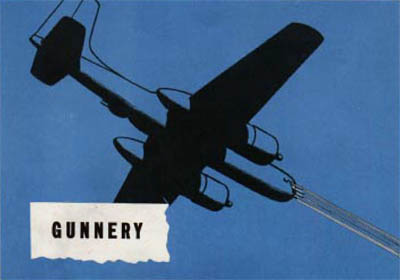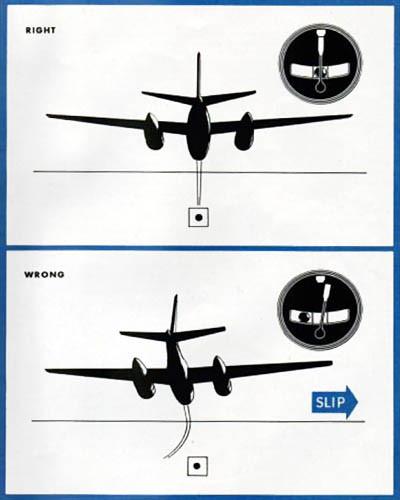Instructions on pilot gunnery in the Douglas A-26 Invader from Pilot Training Manual for the A-26 Invader, Headquarters, AAF, Office of Flying Safety.
No other plane in the Army packs the forward firepower of the A-26. It is designed, among other uses, for low-level attack and strafing. You must know the location of all your gun switches, how to load your guns, and the principle of air-to-ground gunnery.
All the guns must be loaded and charged while on the ground. Under most circumstances, you don’t have to do this yourself, but the time may come when knowing how to load your gun will save your life. See your armament officer for this information.
When you charge your guns, be certain that the airplane is pointed where there is absolutely no danger of hitting anything or anyone in case of an accidental firing (preferably a gun abutment).
Air-to-ground Gunnery (Fixed)
For air-to-ground fixed gunnery, considerable skill is required. Here are some points:
1. Know and abide by all the range rules.
2. Have good radio contact and guard the range control throughout the entire mission.
3. Set your rpm at about 2200 and use throttles as needed to hold airspeed.
4. Turn on your gunsight and adjust it to 0° elevation.
5. On your fire control panel, switch your top switch on GUN AND CAMERA.
Now set up your pattern, which in most cases is an ordinary rectangular pattern at 1,000 feet. Make a few dry runs on the target with your actual approach path at about a 40° angle with the ground. On these passes, trim your plane up so that at the time you normally would be firing (1000 to 500 feet from the target), the needle and ball are centered exactly. Your airspeed at the time of firing will be between 260 IAS and 280 IAS. From the accompanying illustration, you can see why it is necessary to center the needle and ball.
When using the gunsight, keep both eyes open. When you have accomplished the foregoing procedure, you are ready to fire. Do not turn on the FIRE CONTROL switch on the fire control panel until you have rolled out of your last turn and are lined up with the target.
Then put the bead on the target with coordinated use of stick and rudder. Once the bead is on the target, freeze on the rudder and make last little corrections with the aileron. Above all, hold the rudder steady while you are actually firing. Fire short bursts of no more than 20 continuous rounds per gun.
Correct for wind drift by dropping a wing into the wind, but keep the ball is the center.
Pull out well over the target, because bullets and dirt ricochet and may possibly come back through the windshield.
As you chandelle up off the target, your first duty is to turn off the FIRE CONTROL switch on the fire control panel.
Don’t be afraid to make plenty of dry runs, and don’t waste ammunition.
Air-to-ground Strafing
Strafing differs from target gunnery in that you fly to your target at a low level and pull up and dive on the target to strafe. Make no effort to keep the ball in the center or to hit any one particular target.
The firing procedure is the same, but you use the sight for range only. As you fire, take your eyes off the sight and watch the targets.
Gently fan your rudder enough to cover the width of the targets with your fire. Here again, make your bursts as short as possible.
Do not make your approach too flat, or your bullets tend to go over the target.
Air-to-air Fixed Gunnery (Tow Target)
Remember these simple rules.
1. Do not turn on the FIRE CONTROL switch until you are reedy to fire.
2. Be certain that the tow-target plane is not lined up with the target.
3. As soon as you have made your pass, turn off the FIRE CONTROL switch.
4. Always maintain radio contact with the tow-target plane.
3. Study gunnery manual on how to lead or trail the target.
Flexible Gunnery
During your fixed gunnery, the only person over whom you had to exert control was yourself. In flexible gunnery you control your fire through the rear gunner. This means that you need the ultimate in air discipline.
Instill this into your gunner. Insist that he wear his headset at all times. Make your radio and interphone communications as brief and concise as possible. Never take off until your gunner understands his duties thoroughly and is fully briefed on how the mission is to be run.
Learn your gunner’s problems by having a bull session upon the completion of each mission.
Air-to-ground Flexible Gunnery
Fly your pattern to give your gunner good, clear shots. Watch your tell-tale indicator. Know at all tines where the gunner is tracking. Teamwork is the road to success.
Air-to-air Flexible Gunnery
Proficiency in air-to-air flexible gunnery is your insurance against enemy fighter opposition. Air discipline and teamwork is the secret.
Have the gunner call off the position of the other plane in terms of the clock system “3 o’clock low,” “6 o’clock high,” etc. Camera guns are used in air-to-air gunnery to check your gunner’s marksmanship, and your job is to follow your leader in good formation whilst the “enemy” planes make passes.
On every mission you and your gunner must be constantly searching the sky for other aircraft. Get into the habit of calling their position off to one another at all times during flight. The gunner should track these “enemy” aircraft, with empty guns only, to gain proficiency.












Shoot it.